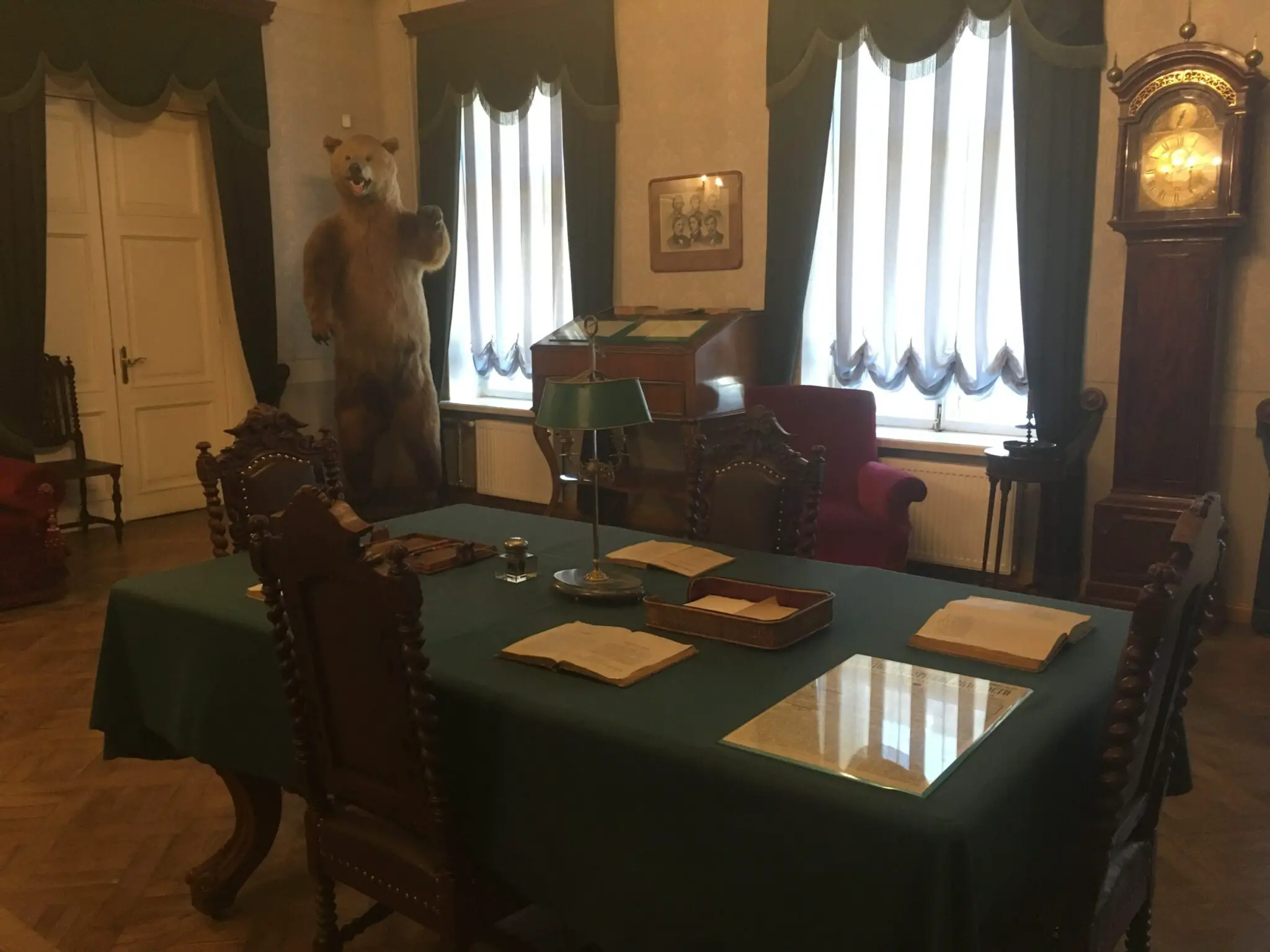Nikolai Nekrasov is one of Russia’s most famous poets and literary thinkers. While he is not as recognized abroad as some of his contemporaries like Tolstoy, Dostoevsky, and Turgenev, Nekrasov was a great influence on their careers as well as to as to the intellectual thought of the time that affected many of these great men’s writings.
Nekrasov’s former apartment is well-maintained as a museum in his honor at 36 Liteiny in St. Petersburg. The exterior of the building is in good condition and the interior looks as though it has been maintained in the same condition since the poet lived there.

Like most of the many literary house museums in St. Petersburg, the museum’s story is told through an audio guide and the staff will strongly advise that you rent one when you visit.
The only information available otherwise is written only in Russian on a couple of sheets of laminated paper in each room.
This is where differences with other house museums come in. Many other museums overflow with language options for the audio tour. The Nekrasov Museum offers two: English and Russian. Further, most guides in other museums use fairly professional British actors reading through narratives. Nekrasov’s guide has an American accent and is slow and sometimes awkward as she reads through material that sounds more like a history textbook.
As Nekrasov is not as well known outside of Russia, it’s obvious that the museum management is not expecting a diverse international crowd. The heavier tone to the guide can probably be explained by the fact that Nekrasov’s major contributions to Russian literature were, in fact, historical and intellectual.
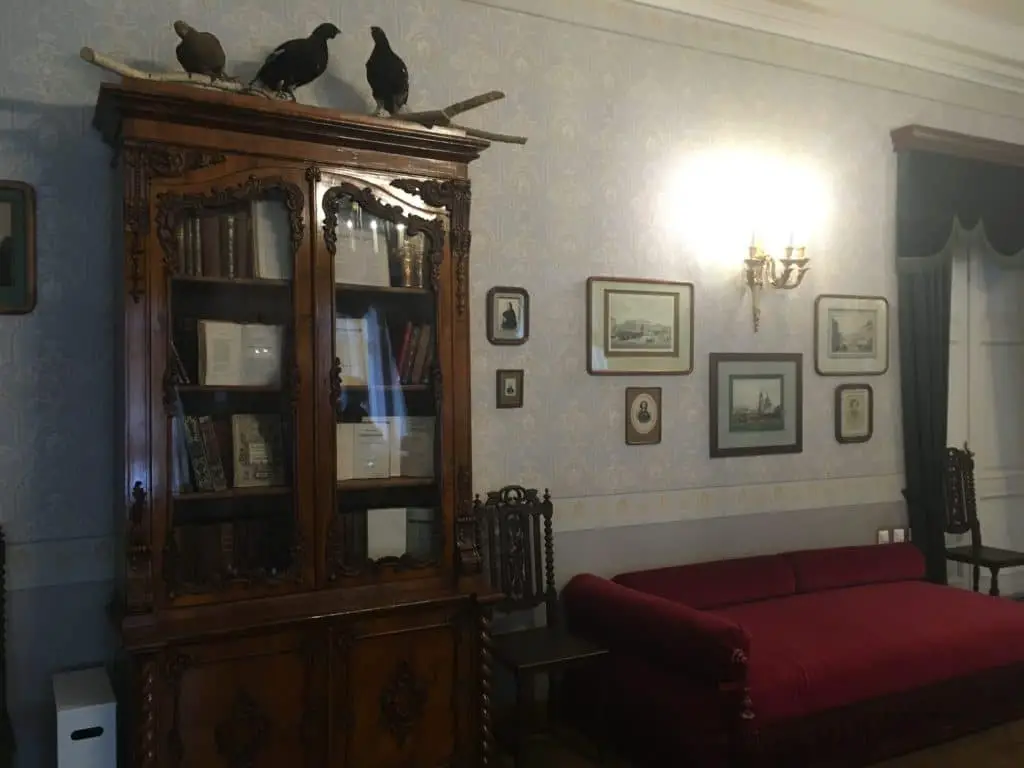
As you enter the main room, which was used as an editing room and a meeting place, the audio guide informs that Nekrasov resided and worked in this home from 1857 to his death in 1877. During these years the apartment was the editorial office of two progressive and popular magazines: The Contemporary and Notes of the Fatherland. Turgenev, Tolstoy, Ostrovsky, Dostoyevsky, and other famous Russian writers contributed to the journals and, thus, frequented the apartment. The audio guide then reads a quote from Nekrasov’s biographer, P.A. Gaydeburg: “the history of these rooms is the history of literary relations of an entire era, the history of Russian journalism.” The museum thus most emphasizes Nekrasov’s overall place in Russian literary history.
The original parquet flooring starts in the main room and flows throughout the museum. The room is elaborately decorated with taxidermied animals, which the guide informs is a nod towards Nekrasov’s love of hunting. The focus of this room, however, is Nekrasov’s connection to the Russian literary world. On the walls are photos of his contemporary writers and thinkers like Belinsky, Turgenev, and Dostoyevsky. The guide further asserts that by first publishing the works of Dostoyevsky and Tolstoy, Nekrasov introduced the pair into the Russian literary canon.
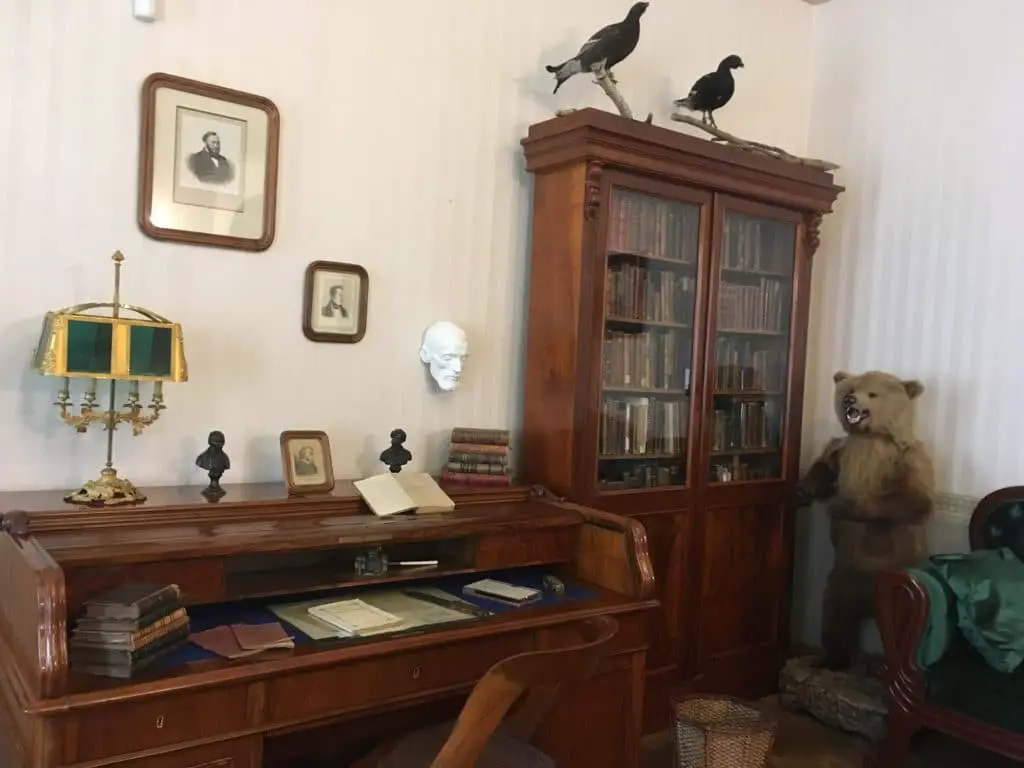
Furthermore, it was in this main room that Nekrasov developed a close relationship with the famous Russian writer, Ivan Turgenev. On display are a pair of tenderly written letters between the two authors. The pair were brought together in friendship by their mutual adoration of Vissarion Belinsky, a Russian “westernizer” philosopher and critic of the time. In this room, Nekrasov edited Turgenev’s story Notes on a Hunter, which was first published in The Contemporary.
The next room is the writing room, which was not only Nekrasov’s private office but also the magazine’s headquarters where Nikolai Chernyshevsky and Nikolai Dobrolyubov both worked. Although the room is also decorated with taxidermy animals, the emphasis is on Nekrasov’s original desk, which is covered in original manuscripts and letters, and on the communal desk shared by those that worked at the magazine.
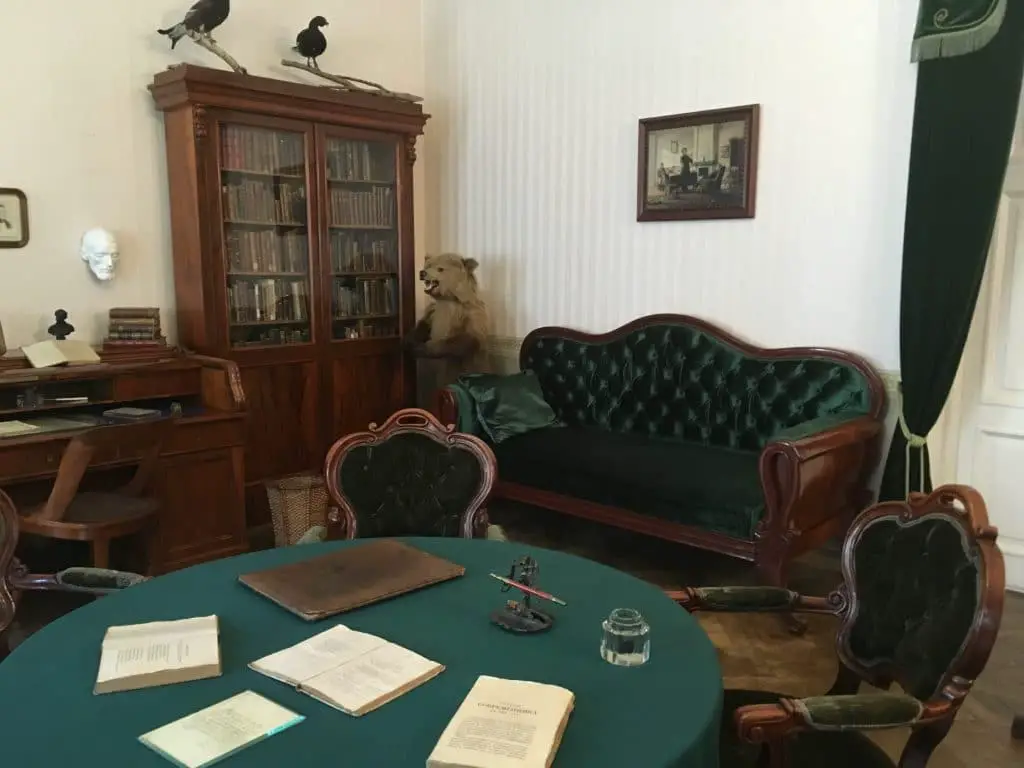
In this room, the guide discusses the split of the editorial board of The Contemporary, and the end of Turgenev and Nekrasov’s close friendship. In 1959 Nekrasov invited Dobrolyubov to join the editorial board of the magazine. This outraged Turgenev as Nekrasov approved the publication of Dobrolyubov’s negative review of Turgenev. Shortly after the pair ended their friendship, the magazine staff split into two groups. One group, headed by Turgenev, Lev Tolstoy, and Vasily Botkin published realism that followed Pushkin’s tone and style and targeted the Russian nobility. The other group was headed by Nekrasov, Chernyshevsky, and Dobrolyubov who published satirical literature inspired by Gogol that strove to be more democratic and inclusive. In the split, Nekrasov supported controversial opinions such as the revolutionary raznochintsy and the ideologies of the peasant democracy. During this time period Nekrasov wrote “The Poet and the Citizen,” “Reflections at the Front Door,” and “The Railway.”
In the sitting room, the guide delves into Nekrasov’s 17-year intimate and professional relationship with Avdotya Panayeva. Although the pair never officially married, Panayeva was considered to be Nekrasov’s civil wife. The pair’s complex and sometimes toxic relationship was the inspiration of the “Panaevsky Cycle,” a series of original love poems written by Nekrasov.
While working at The Contemporary, Panayeva was not only Nekrasov’s partner but also a writer in her own right under the penname N.N. Stanitsky. Under this name she published a series of novels and short stories. The audio guide informs you that Panayeva’s best known work was entitled “Memoirs” and contains a lengthy description of the literary circle surrounding Belinsky and The Contemporary.
The sitting room is warmly decorated with burgundy curtains and seats and bright wall paper. The deep reds and pinks as well as the bright lighting are welcoming. On display are copies of Nekrasov’s long adventure novels which he co-wrote with Panayeva, The Three Countries of the World and The Dead Lake, which both appeared in The Contemporary.

In the dining room the audio guide begins to describe the downfall of The Contemporary. The room appears welcoming as the focal point is a large table that hosted a variety of writers and poets. This is overshadowed by the tale the guide tells of the dissolution of the magazine. In 1861 Dobrolyubov died and Chernyshevsky was exiled to Siberia, leaving Nekrasov alone in his faction. During this period, The Contemporary received a first political warning from the Russian Tsar, who was upset by the journal’s support of peasant uprisings in Poland. For the next five years, Nekrasov struggled with state censorship. In the culmination of this struggle in 1866, in the kitchen of his apartment, under pressure of the Tsar, Nekrasov signed papers to close the magazine forever.
After this, however, Nekrasov began to rent a publishing house to create Notes on the Fatherland, from Andrei Krayevsky. The magazine became well-known to liberal-minded Russian readers. The magazine also first published Dostoyevsky’s The Adolescent.
Finally, you are taken into Nekrasov’s bedroom where you learn of his final work published in Notes on the Fatherland, a four part poem entitled “Who is Happy in Russia?” In the poem Nekrasov narrates the quest of seven peasants through Russia to find a happy man after the abolishment of serfdom. These epic poems, the audio guide informs, marked Nekrasov’s unique style that focuses in on ordinary people as heroes ruined by the deceptive city of St Petersburg. The poem is still popular and regularly cited by Russian liberals and social critics.
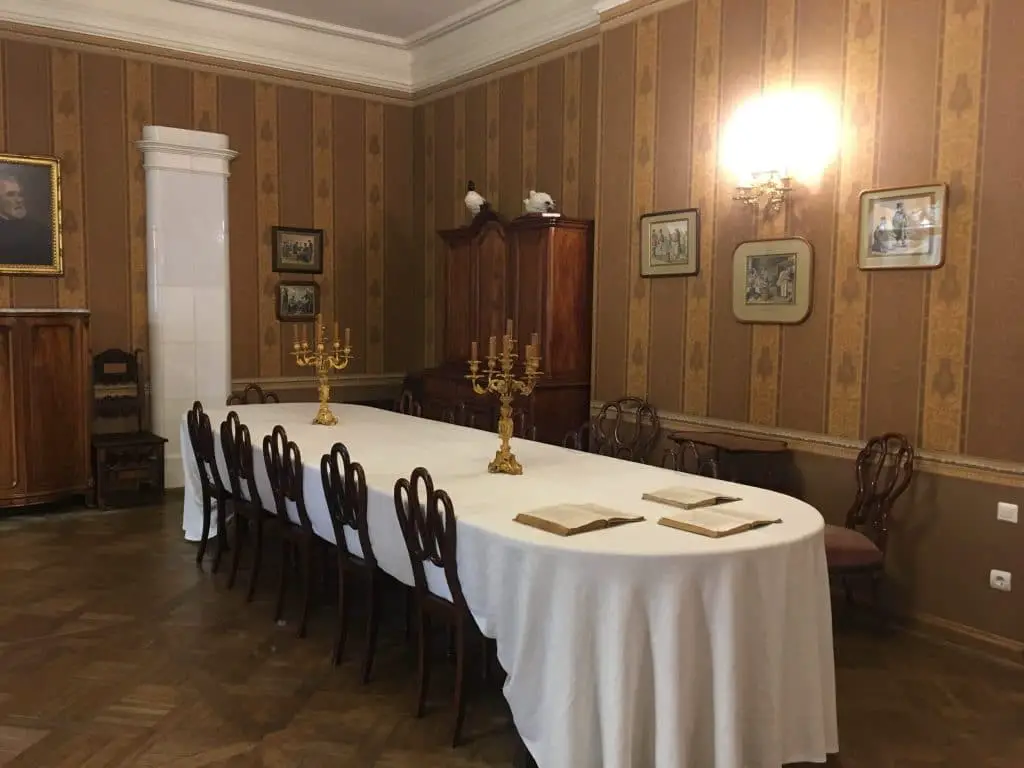
Nekrasov’s bedroom is recreated based on a painting that hangs in the room. It depicts the final moments of his life where he is bedridden with intestinal cancer. Although the room features a small desk, the poet was unable to write in the final weeks of his life. The room is dark compared to the other rooms, reflecting the sorrow the literary world felt after his passing.
Undeniably, Nekrasov contributed to Russia’s literary culture by publishing Russian authors who would become canonical and by fighting against censorship. As a writer, Nekrasov was also highly influential and contributed greatly to the conversation advocating for the rights and freedoms of the lower classes. His literature and magazines mark an important part of St. Petersburg’s cultural history. Although currently neglected by international audiences, a visit to his memorial apartment is informative on many counts of the Russian cultural and political history that he greatly influenced.
The Memorial Museum-Apartment of Nikolai Nekrasov
36 Liteiny, St Petersburg
Hours: Open daily from 10:30 to 18:00. Except Thursday 12:00 to 20:00. Closed Tuesday.
Admission: Adults $120 RUB, under 16 free, Students from 16 years 60 RUB, Pensioners 60 Rubles. Audio guide: 110 RUB.


